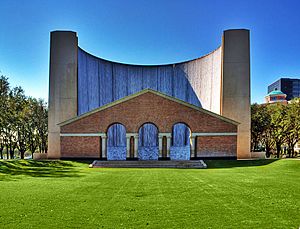Gerald D. Hines Waterwall Park facts for kids
The Gerald D. Hines Waterwall Park is a huge, beautiful fountain in Houston, Texas. It used to be called the Williams Waterwall and the Transco Waterwall. This amazing fountain stands across from the Williams Tower in the Uptown area. The fountain and the park around it were built to make the nearby tower look even better. Both the fountain and the tower were designed by John Burgee Architects with Philip Johnson. The Waterwall was once privately owned, but in 2008, a local non-profit group bought it. This was done to make sure the Waterwall and its park would be protected for a long time. You can usually see the fountain running between 10 AM and 9 PM.
Contents
Building the Waterwall
John Burgee Architects and Philip Johnson started working on the Transco Tower (now Williams Tower) and its park in 1982. They worked with a developer named Gerald D. Hines. The office tower was finished in 1983, about 18 months later. The Waterwall itself was fully working and open to the public by 1985.
What the Waterwall Looks Like
The architects wanted the Waterwall to look like a "horseshoe of rushing water." It faces the Transco (now Williams) Tower. This curved fountain is 64 feet (20 m) tall. This height was chosen to match the 64 stories of the tower. It stands among 118 Texas live oak trees.
The curved part of the fountain that faces the tower has a special arch in front of it. The back of the fountain faces Hidalgo Street. Water flows down in large sheets from the narrow top of the circle to the wider bottom. This happens on both the front and back sides. It creates a stunning waterfall that you can see from many buildings nearby.
About 46,500 square feet (4,320 m2) of water covers the inside of the fountain. Another 35,000 square feet (3,300 m2) covers the outside. The main part of the fountain is made from St. Joe brick. However, the arches are made of Indiana Buss limestone. The bottom of the wall is black granite. The fountain holds 78,500 gallons of water. This water is recycled and cleaned by a special system every three hours and two minutes.
Fun Facts About the Waterwall
Locals often just call it "The Waterwall." It's a very popular place for both tourists and people who live in Houston. Many people visit to take photos, have picnics, or enjoy concerts. It's a well-known landmark in Houston.
On September 23, 1987, former Oiler quarterback Dan Pastorini got married at the Waterwall.
The Waterwall was an "official sight" during the 1992 Republican National Convention.
Several movies have filmed scenes at the Waterwall:
- In 2001, the TV movie The Way She Moves was filmed here.
- The Bollywood song Dilbar Dilbar from the movie Sirf Tum was shot at the Waterwall.
- In 2013, the TV movie The Preacher's Mistress also had a scene filmed in front of the Waterwall.
- The 1992 Chuck Norris film Sidekicks included parts filmed at the Waterwall.
In 2012, a special performance called "Natural Acts in Artificial Water" took place at the Waterwall. It was created by director Stephan Koplowitz.
How the Waterwall Got Its Name
The Waterwall was first called the "Transco Waterwall." This was because of the Transco Energy Co. that owned the nearby tower. Later, Transco Energy Co. merged with the Williams Companies. So, the tower and the Waterwall were renamed the "Williams Waterfall."
On December 17, 2009, the City of Houston changed the name again. They renamed it the "Gerald D. Hines Waterwall Park." This was to honor Gerald D. Hines for his big impact on Houston's architecture over many years.




